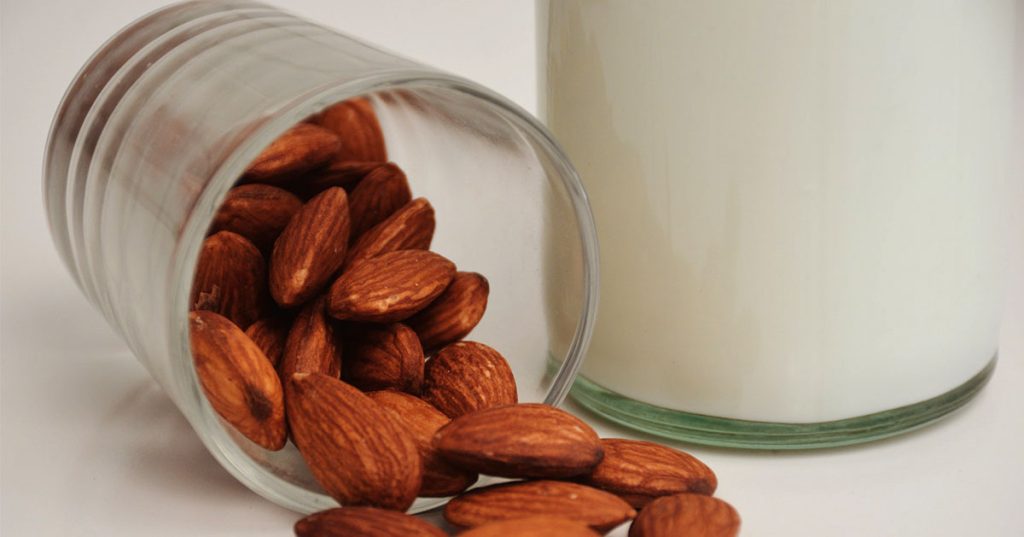Milk has been a staple of the American diet for every generation. Children are told their bones will grow strong when they have a glass of milk. It is our first meal from our mother, but then becomes replaced by another form. For many years, the only type that existed was cow’s milk. Today, almond milk has become an alternative causing a debate questioning which is the better choice.

In the battle of cow’s vs almond milk, the winner might be a matter of personal preference. Here’s how they stack up:
Cow Milk
One percent low fat milk contains about 110 calories, 2% contains 130 calories, and whole milk has about 150 calories per cup. 90% of the world’s milk comes from dairy farms. There has been questioning about the cleanliness and humanity of this process. Some even argue that cow’s milk is not actually meant for human consumption. Milk is made up of lactose, which is the most common food allergy in the world. Despite all this, cow’s milk does have quite a bit of nutritional value. In just one cup of milk, there contains 305 milligrams of calcium. This is needed for bone health, our teeth, and blood health. Cow’s milk also has choline which is a nutrient that helps with memory, sleep, and muscle development. It also contains potassium and Vitamin D. The major downfall is that this milk is high in saturated fat. This is an important consideration for person’s with diabetes or heart disease.
Almond Milk
Almond milk generally contains fewer calories. Unsweetened almond milk has a mere 30 calories per one cup. The process of making almond milk is similar to brewing coffee. However, the final product does not contain the same amount of nutrients as whole raw almonds. Some of the calcium, fiber, and protein is lost in this process. Therefore, many almond milk products are fortified with nutrients to help make it look comparable to cow’s milk. Almond milk is naturally lactose free which can help those with digestive issues. It is also environmentally sustainable due to the major cultivation of almonds. Almond milk contains healthy Omega 3 fatty acids. This can help lower bad cholesterol levels.
When it comes down to the final winner, the decision is primarily based on a person’s dietary needs. For someone who is trying to lower their cholesterol and keep their blood sugar down, almond milk would be the winner. For someone who is active and still growing and developing, cow’s milk might be the winner. Again, this would all depend if a person is lactose intolerant. The world of milk has changed with many different varieties now available. A bowl of cereal just isn’t a bowl of cereal without milk, no matter what kind.
A new game changer has been the spark in attention for chocolate milk. Both traditional milk and almond milk can come in this tasty flavor too.

At the outset, one might question chocolate anything being beneficial to our health, and this beverage is normally a mixture of the milk type with cocoa and other sweeteners (sometimes even high-fructose corn syrup). A little higher in sugar and carbs then most might desire, but the benefits might override these factors. 1 cup has about 200 calories and 30 carbohydrates as well as 28% of the recommended daily intake (RDI) for calcium, 25% RDI for vitamin D, 24% for riboflavin, and 25% for phosphorus. All of these are great for bone health.
Avid exercisers and athletes have become fond of drinking chocolate milk because of its contribution to muscle recovery post-workouts. Here is where the carbs and sugar can actually be beneficially, and it is also important to remember that milk is considered a protein with all the essential amino acids. Studies have not proven the effects of chocolate milk are any better than any other type of recovery sports drink.
Including milk of any form in your diet can be great for you bones and hormones, but that is not the case for everyone. Some people have an intolerance to milk that can cause abdominal pain and bowel problems. A person that is lactose intolerant has a condition in which their small intestine doesn’t produce enough of the enzyme lactase. Lactase is needed to break down and digest dairy, so if you aren’t able to do so then discomfort can result. For some people irritable bowel syndrome (IBS) can be triggered by dairy products. This can result in stomach cramping and chronic diarrhea. In this case, milk should certainly be avoided. Some people are also simply allergic to milk. Their body treats it like a foreign substance. Children usually outgrow milk allergies by the age of three. Symptoms include itchy skin and hives after drinking. There are supplements that can help a person break down and digest dairy if they desire to have it. This way they don’t have to completely eliminate them.
As adults, we don’t always drink milk like we used to as kids. Maybe a little with cereal, oats, or coffee here and there, but overall, we don’t have it with dinner anymore. Milk is a tricky portion distortion problem for some people. Have you ever added more milk because you have a little cereal left? Have you ever thought cookies and milk sounded good and then you keep eating the cookies, so you keep drinking the milk with them? Sticking to drinking just once cup is out of the question many times. For kids, milk is certainly the better option versus soda or sugary fruit juice. Families buy gallons for their kids. There’s a type for everyone’s taste buds depending on what type you buy. Skim or 2% are the most popular options, but then again, some people even like buttermilk. Milk is great for our bodies, and well, chocolate milk makes it case, but not too convincingly. Let’s face it any excuse to add some chocolate to anything can be attractive. Our society keeps the cows busy, but certainly not by those who are lactose intolerant.
Originally printed on Every BODY’s Fit blog. Reprinted with permission.
Dr. Megan Johnson McCullough, owner of Every BODY’s Fit in Oceanside CA, is a NASM Master Trainer, AFAA group exercise instructor, and specializes in Fitness Nutrition, Weight Management, Senior Fitness, Corrective Exercise, and Drug and Alcohol Recovery. She’s also a Wellness Coach, holds an M.A. Physical Education & Health and a Ph.D in Health and Human Performance. She is a professional natural bodybuilder, fitness model, and published author.

